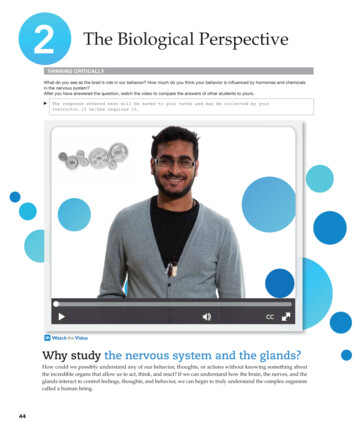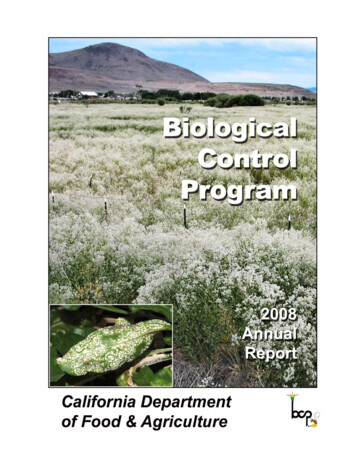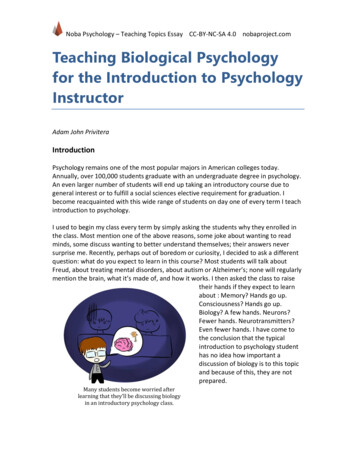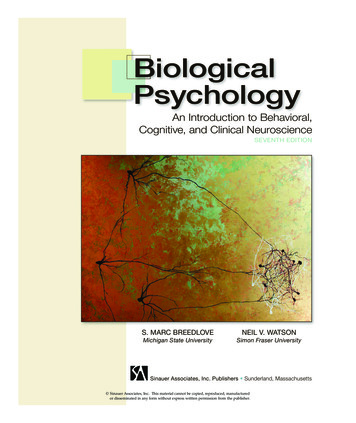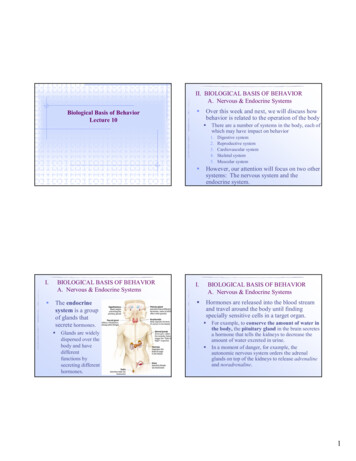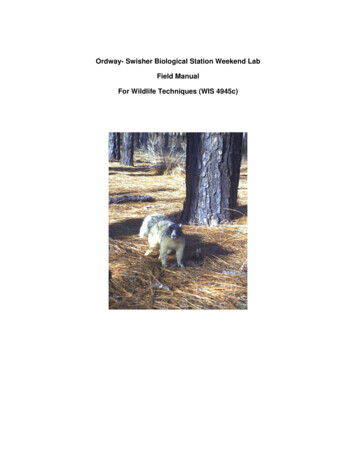
Transcription
Ordway- Swisher Biological Station Weekend LabField ManualFor Wildlife Techniques (WIS 4945c)
Tentative schedule of activities for Ordway Field tripThis schedule is meant to give you a rough outline of the weekend field trip. However itis likely that changes will be made based on conditions in the field, weather, andlogistics. The 1s and 2s are to indicate the groups that will be assigned to each activity.Friday7:00 -10:0010:00-12:3012:30 - 1:302:00-3:303:30 -4:304:30-6:00Arrival/ set upcamp1. S. mammal setup2. Amphibians,meso-mammaltrapsSaturdaySunday1. Small mammals2. Small mammals2. Bird/meso-mam.1. Bird/meso-mam.1. Amphibians2.Insect lab2. Insect lab1. AmphibianLunch/breakClean camp/ CleanTraps/ Depart1 & 2.Frogs, gophertortoise, P. gopher2. Small Mammalsetup1. Meso mammals/Squirrels6:00-7:00DinnerDinner7:30- 10:00(gators)1. Call backs, FLIR,spotlighting1. Call backs, FLIR,spotlighting7:45- 10:002. Gators2. Gators(Spotlight)
Field NotebookUsing a field notebookBeing a wildlife professional means that you are a naturalist who makes observationsabout the natural environment and the interaction among animals, plants and the land. Itis through these types of observations that you will develop an understanding of thenatural world. These observations can also help us ask questions that lead to scientificresearch. From Darwin to Leopold on to the present the best method for recordingobservations, thoughts and activities in the field has been the field notebook. Bykeeping a field notebook you will be able to develop your observation and interpretiveskills and to keep a permanent record of your activities.ContentYour field notebook will consist of accurate accounts of your field activities. Theinformation in this notebook should be entered in the field, neatness is not the priorityand accuracy is. For your time at the Ordway you will have 2 equally important types ofentries into your notebook. The first types of entries will detail your experiences duringorganized lab exercises. The second type of entry will detail all of the observations,interpretations and reflections that you have outside of organized activities. This couldinclude anything from the birds you saw while you were eating breakfast, to the tracksthat you saw in the sand while setting traps.EssentialsFor every entry there basic information that you should include is information on thetime, weather, temperature, wind or any other factors that you think will influence thepresence or behavior of wildlife. You should also include a brief description of thevegetative communities where your observations occurred. Next it is important to putdown your location, the more precise the better. Use a GPS when you can.Additionally, provide a brief description of where you are. It is also OK if you want tomake a map. Finally give a brief description of what you are doing (walking, smallmammal trapping,etc.)The DetailsLab assignments. After you have entered the essentials, use your note book to recorddata collected during the lab. Some things you might record include: species, weight,tag number, location and type of trap and any relevant comments. After the assignmentis over take time to summarize your results and make any observations orinterpretationsInformal observations. This allows you more freedom to record your personalobservation of animal signs, sightings, interactions, and behaviors. The content of thissection should be detailed enough for future use and interpretation. You areencouraged to include sketches. If you take pictures be sure to enter that information inyour notebook. Finally, don’t be afraid to interpret what you see and to proposehypotheses and explanations.Your Grade
This is a 40 point assignment. You can receive up to 20 points for lab assignmententrees and 20 points for Informal observations. Each section will be graded for 3categories: content (10 points), interpretations (5 points), and clarity (5 points) .Small Mammal Trapping NotesTrap placements- Place traps next to natural objects (trees, braches, etc.) or on paths. Placetrap entrance flush with the ground.Food– Traps are commonly baited with peanut butter and oats, bird seed, or cracked corn. It iscommon to rebait traps every day or two.Bedding- If it gets cold at night researchers will often provide bedding to help small mammalsregulate their temperature.Checking traps – Small mammal traps can usually be checked once a day in the morning.However, in some instances when small mammal maybe active during the dayit is best tocheck traps every 2-3 hours.Sexing and Aging- A mature rodent can be sexed by the presence of nipples and developedtesticles. Immature rodents require an examination of the distance between the anus and sexorgans (Figure 1)Small mammals on the OrdwayFlorida mouse (upland pine/common) --186–221 mm in total length. Its tail is shorterthan the body, 80–100 mm long. Distinguished from old field mouse and cotton mouseby the 5 pads (plantar tubercles)Cottonmouse and old field mouse (Peromyscus spp)-- (All habitats/common) can havedarker pelage on back but color varies. Distinctly bicolored tail. The cotton mouse andoldfield mouse both have 6-7 plantar tubercles (Figure 1)Golden Mouse (Mesic Hammocks/uncommon) – Cinnamon orange coat. Tail issmaller than head and body, scantily haired and is not bicolored.Cotton rat (around ponds and old fields/locally common). A larger rodent with a short tailand distinct hispid (salt and pepper) coloration that covers its body.Rice rat (aquatic environments/ uncommon). Darker fur with lighter under parts and feet.Slender, almost naked tail is a distinctive featureWoodrats (hammocks/ locally common). Larger rodents with large rounded ear. Tail hashair and is bicolored.
Figure 1. Sexing and aging rodentsFigure 2. Florida mouse 5 tubercles vs. cotton mouse with 6tubercles
Capture of Raccon and Mid-sized MammalsTraps The medium-sized mammal trap is usually constructed of heavy 12, 14, or 16 gaugegalvanized steel wire mesh for maximum resistance to rust and corrosion. An open fabricconstruction allows the animals to see through the trap in all directions and enter the trap withconfidence. Galvanized steel rods are welded to the wire mesh frame for extra support andreinforcement. A spring loaded, automatic locking V-door, securely and safely traps the animalinside the trap immediately after the animal steps onto the trip pan, located at the back of thetrap. Galvanized ½ by ½ inch wire mesh openings are welded to the bait areas to preventanimals from reaching through the outside of the trap. A spring-loaded door eliminated thechance of an animal backing out of the trap before the door springs shut and locks into place.The special locking system and the heavy reinforcement of the trapdoors prohibits animalsfrom forcing the door open, even if the animal manages to turn the trap upside down.Tomahawk Live TrapAnimal Control Pole
Callbacks and Spotlighting ExerciseObjectivesThe objectives of these exercises are to familiarize students with broadcast surveys andspotlight counts. At the end of the lab students should have a better understanding of thehabitat associations of owls and a rough idea of the density of deer or the OrdwayCallbacksBroadcast or callback surveys are one of the most widely used techniques to locate andsurvey owls. This survey technique has been used to document the range and status ofseveral owl species in North America, and can also be used to determine habitat associationsof owls. This technique is commonly used to collect presence/absence data, and is not usuallyused to estimate density owl. For this lab we should gain an understanding of which owls areusing which habitats.ProceduresWe will be driving around the Ordway to access different broadcast stations for owls. Thebroadcast stations have been stratified (by habitats) so we can assess owl communities indifferent habitat types. We will try and conduct at least 4 broadcasts in each habitat type.1.2.3.At each playback station, we will broadcast vocalizations of various species of owl usinghandheld mp3 player in 4 cardinal directions. We will start with the smallest species andfinish with the largest.After each broadcast we will Listen for responses for 3 minutes, and record species thatresponded, and direction it came.Repeat steps 1 and 2 for each owl species at each station.SpotlightingSurveying of nocturnal mammals has traditionally been done with spotlight surveys. Spotlightsurveys usually consist of researchers driving roads at a slow but constant speed recording theanimals that are seen within a set distance from the road. Mammals are especially easy to seebecause they have eyes that reflect light (allowing them to see better in the dark). Spotlightsurveys have some inherent problems with convince sampling and detection rate (notaccounted for). In general they are not used to give robust estimates of density; however,spotlight surveys can provide an index of relative abundance for easily detectable speciessuch as white-tailed deer and can be quite useful to private landowners trying to assesspopulations on their property. Spotlighting can also provide useful information on the habitatassociations of animals.
ProceduresFor this lab we will be driving to callback stations. While we are driving we will also be usingour spotlight to estimate the deer population and to note any additional species we see alongthe way.1.2.3.4.5.Note the odometer reading at the start of the driveDrive at a slow speed. Shine spotlights in an arc on both sides of the vehicle looking foreye shine. If you see something ask the driver to stop. Use your binoculars to determinethe number of deer at that location.At each playback station, before you leave take the time to estimate how far off the roadyou can see deer. Use this information to estimate the area of the strip width covered byyour survey.Record the final distance on the odometer to determine the W and L of the Fixed WidthtransectUse the formula from the gopher tortoise lab to come up with a rough estimate of thedeer population on the Ordway.1 mile 1609 meters10,000m2 1 ha
ORDWAY-SWISHER ALLIGATOR LAB*information from this manual was adapted from the USGS alligator capture protocol and FWC’s 2010 statewidealligator harvest training and orientation manual.OBJECTIVEIn this lab you will practice capturing and marking alligators and collecting data on alligators and theirenvironment.PROCEEDURESStudents will divide into 3 groups. Each group is responsible for catching one alligator under 2 feet longand recording data on the alligator and its environment. Each student will participate in alligatorcaptures, and turn in a data sheet with their groups’ alligator data on it. Alligators will be captured eitherfrom canoe or from the shore. Students will use the hand grab method or tongs for capture. Alligatorswill be brought back to the boat ramp for data collection. Please refer to the following directions forcapture methods and safety protocols.*There will be alligator biologists from FWC and USGS assisting with captures. In the event a largeralligator is caught by professionals, all groups will report to the boat ramp and assist with working upthat animal.This lab will take place between 19:30-20:00 hours. You will need:This manualA head lamp (or flashlight)Close toed water shoespencilbug sprayjacketOVERVIEWSurvey methodsFlorida alligator populations are surveyed by conducting night light counts. Surveys are typicallyconducted on open water bodies from an airboat, during early summer months (April, May, June) whenthe most alligators are visible. Later in the summer females are back in the marshes nesting and are notin the open water, and during colder months alligators are not as active. The surveyor shines a spotlightin a 180 degree arc in front of the boat and counts the number of alligator eye shines and places eachanimal in an estimated size class based on head size and habitat. This is an index count and many thingsincluding the weather and surveyor affect the outcome of the count. Therefore protocols state that theweather should be fair, the boat should run at 20 mph, and surveyors be highly trained to help alleviatesome of the bias.* The eye-shine of an alligator, (and other nocturnal vertebrates), is caused by a layer of cells called thetapetum lucidum This structure is located beneath the photoreceptor cells (rods and cones) in the retinaand reflects light back into these cells to increase the amount of light detected, which improves an
alligator's vision in low light conditions. In alligators this eye-shine is red, but it can be different colorsin other species ( FWCs alligator fact sheet).Capture methodsSeveral methods are used to capture alligators. The best capture method will vary depending on the sizeof the alligator, the habitat, time of day, and available equipment or personnel. There are a few commonsteps in all effective capture techniques. Alligators are usually captured after dark, Alligators should beapproached quietly keeping the beam of the spotlight directly in or just above their eyes, directly aftercapture the mouths are secured shut.Hand grabThe appropriate size for hand capture is less than 5 feet. Most effective at night from a boat. Never hand capture an alligator that is too big for you to handle. Grab the alligator behind the neck. Never grab an alligator on any other part of its body. Keep the alligator at arm’s length. Never bring an alligator into your body. With one hand hold the alligators neck, with the other hand close its’ mouth, while anotherperson tapes it shut.Break away snaresA snare should be carefully slipped over the alligator’s head when it is close to the boat. It is best to usea snare that has been attached to a pole with a rubber band or piece of tape so that it will "break-away"after pulling the rope to set the snare. The alligator will eventually tire after it has struggled against thesnare rope. Snares are most effective when it is possible to get within a few feel of a large animalusually at night. Most commonly they are used as a reinforcement after an alligator has been captured byother means such as a snatch hook, harpoon, or baited wooden peg.
Alligators should be snared around the neck. Securing the alligator around the neck allows forcontrol of the animal. In the event that an alligator is snared around its body or tail, a secondsnare should be place around the neck as soon as possible to gain better control.Alligators should not be brought on board until they are tired. As they tire they will begin to rollmore and more slowly until they are barely turning over.Once the captain has determined the alligator is spent, the captain will secure the mouth with amouth snare or other securing device.Once the mouth is secured by the snare, the captain will grab the mouth for the catcher to secureclosed with tape or rubber bands and tape. No alligator is to be brought onto the boat without itsmouth secured.After the mouth is secured, the alligator can be brought onto the boat to be measured. Pressuremust be applied to the alligator at all times, to maintain control over the animal while it isonboard and to prevent it from escaping.Once measurements have been recorded, the alligator is ready to be released. The release ropewill be tied to the boat. The other end of the release rope will be tied to the tape and rubberbands around the mouth. During the attachment process, the head will be secured to ensure thatthe alligator does not pull the tape off before it is in the water.The tape and rubber bands can be removed once the alligator is in the water by pulling on therelease rope. Care must be taken to ensure that the tape and rubber bands have been removed.Snares should be prepared for the next capture prior to leaving the capture site to look for thenext animal.Catch polesCatch poles may sometimes be used in place of snares. They are most useful for capturing alligators inthe 90 to 150 cm size range, especially when they are on land and it is more difficult to hand grab them.However, the stiff metal pole may be a hazard if used on large alligators ( 150 cm) when the alligatorstarts to spin.
TongsTongs can be used for capturing alligator hatchlings ( 90 cm) that are in difficult locations such as upunder vegetation. Effective in day time or night time. To capture hatchlings try to grab them around the neck or tail and firmly squeeze the handle. Care must be taken to prevent excess pressure from crushing the animal. Release the handle to let the hatchling go. It is very difficult for one person to capture and handle a hatchling due to the tongs length. Thehatchling should be carefully placed into a bucket or handed to another person.Snatch hookA snatch hook is a weighted treble hook attached to a restraining line that is hand-held or used inconjunction with a fishing rod and reel and high-test line. The hook is typically cast over the alligator orover the area where it last submerged. The hook is then retrieved until it contacts the alligator, at whichpoint it is set with a strong pull. The line should be kept tight until the animal fatigues and can beapproached, as the hook often falls out if the line is allowed to go slack. Using the snatch hook tocapture alligators can be useful in areas where alligators submerge before the snare can be used. Before casting, make sure that your casting area is clear.
Try to snatch the alligator on its side. Take care to prevent the alligator from going intovegetation.When the alligator is close enough place a snare on the alligator according to procedures andsecure the mouth.If possible, try to remove the snatch hook before bringing the alligator on the boat.If the snatch hook could not be removed safely before bringing the alligator on the boat, notewhere the snatch hook is and take care not to get caught on it while bringing the alligator on theboat.Remove the snatch hook and perform normal procedures.Toggle dart (Harpoon)Harpoons are commonly used as an effective method for attaching a restraining line to an alligator. Theharpoon point is typically mounted on a pole, arrow shaft, or spear, and the point is attached to a line,similar to the way a break away snare is used. Buoys may be attached to the end of the line.
TrappingBaited wooden pegs less than two (2) inches in length have been used as an effective method forcapturing alligators. A baited wooden peg is attached to a straining line that is hand-held or used with afishing rod and reel and high-test line, or tied to a tree branch.Snare traps set in alligator trails are another method of passive capture.MeasurementsAll measurements must be in centimeters; animal should be as straight and flat as possible.HL: (head length) measured dorsally from tip of snout to center of V at posterior end of skull plates.SVL: (snout-vent length) measured from tip of snout to the posterior margin of the vent.TL: (total length) measured from tip of snout to end of tail. Use measuring board when appropriate.When animals are too long, put marks on the ground at the tip of nose and tip of tail, then move thealligator and use a measuring tape to measure the distance between the two marks.TG: (tail girth) measure tail circumference at break in scale row immediately posterior of vent. (Thirdscute row posterior of vent).WT: (weight) use spring scales to weight alligators of appropriate size. If they are too large we will usethe TL-TG relationship to estimate weight. Mass of animal recorded in grams or kilograms.Sex: use speculum to open vent. Or press down on both sides of the vent, and push the tail ventrally.Males will have a penis.Comments: General body condition, habitat characteristics, capture method, injuries/deformities
SAFTEY ALWAYS ALWAYS ALWAYS keep the alligators’ mouth secure while data are being taken.Pay close attention to alligator tails-they are strong and even on small animals are dangerous.Always have at least two people when conducting captures. Have one person tape the mouthwhile the other person holds the alligator. Do not attempt to tape the alligators mouth until theperson holding the alligator give a signal that the jaws are properly secured.Alligators will wiggle away if they are not being properly restrained. Often they will be docilefor sometime, and then have an explosive fit where they escape with tape still on their mouths.Always keep two hands on the alligator.All water vessels must be equipped with a life jacket/ person, a noise making devise, signalflares, and a cell phone.Do not hand grab anything over 3 feet. And only grab the neck!!Wash hands when done
Alligator data sheet
Date:Time (Mil):Study Unit:Personnel:GPS Location (UTMs): E WAir Temp: (C)Water Temp: (C)Tag number: Prefix ( )Scute clip number:Total Length: (cm) Snout-Vent Length: (cm)Head Length: (cm)Tail Girth: (cm)Weight: (g)Sex:Recapture: Yes / NoHabitat type:Comments:
CAPTURE OF BIRDS USING MIST-NETSObjectives1) Become familiar with mist netting equipment, ideal net locations, and how to set up and takedown nets. 2) Learn proper techniques for handling passerines safely. 3) Learn how to takemeasurements and collect additional data on captured birds.ProceduresStudents will attend participate in 1 mist net capture sessions. During the capture session,students will check nets, observe extraction procedures, handle passerines, and learn to takemeasurements, band, and collect data from captured birds.Why use mist nets? Mist netting is an important technique for population monitoring, and themost common live-capture technique used for small/medium sized birds and bats.Mist nets are used in studies to assess: species compositionpopulation sizerelative abundancedemography (productivity and survival)Mist netting is time intensive and requires specialized training, but it has certain advantagesover visual and aural population monitoring techniques. Mist nets can sample species that arepoorly detected by other means, counts are not subject to observer bias, netting effort is easilystandardized, and each bird counted can also be examined in the hand. Capture allows birdsto be aged, sexed, and marked to allow individual identification in future encounters. Inaddition, data can be collected such as breeding status or sub-species identification,physiological state, molt, parasite loads, DNA Because mist netting is one of the mostefficient means of capturing many bird species, the technique is often used in mark–recapturestudies.Mist nets are most commonly used as passive traps. However, mist nets can also be used totarget specific species or individuals by using audio playback, decoys, baits, herding, orspecial placement of nets (i.e., around nests).What are mist nets? Mist nets are large panels of nylon, polyester, or monofilament mesh,usually 6 or 12m in length. Mesh size can vary according to size of target species. Horizontalstrings (trammels) of thicker, stronger thread are woven through the mesh at the top andbottom of the net and at equal distances in between. Each trammel ends in a loop designed tofit over a pole. The net is strung between two poles, which hold it upright and taut (see figure).The trammels form pockets of netting. Birds fly into the net and usually drop into the pocketsand become entangled. Mist nets are most commonly placed near ground level but can berigged using poles and/or pulleys to hoist nets into the canopy or over water features.
Placement of mist netsNets should be placed: Close enough to all be checked in 10-15 minutes if no birds are caught ( 100m apart). In clear lanes 1-2m wide to avoid getting tangled on vegetation Where they will catch birds. Nets are often set in locations of on the edge of habitats,natural corridors, and near water features where birds will travel.Mist net concerns: Nets catch on clothing and tear. Avoid clothing with buttons, zippers, and velcro. Do notwear jewelry, rings, earrings, and wristwatches. The button on top of baseball caps alsogets caught. Holes in nets not only reduce your catching efficiency, they alsoincrease the probability of severely tangled and injured birds. Keep the bottom pocket off the ground and clear from vegetation; otherwise, birdsget hopelessly entangled in sticks and vegetation, drowned in puddles, dew-soaked,attacked by ants, or can hurt themselves by flapping on the ground. Insects, leaves, and anything else in the net should be removed to reduce visibilityof the net, and to avoid additional tangles when birds are captured. Birds and other animals in nets attract predators, which can injure birds and damagenets. If predators are detected, close a net temporarily or check it more frequently.Weather considerationsNever operate nets in the rain, wet birds suffer hypothermia quickly. Close nets that are in excessive sun during mid day. If windy, close nets which have pockets blowing out “full sail” in the breeze. Small birdscaptured in such conditions can suffer strain, injury, or be literally ripped apart as the netblows open.
Checking netsThe longer a bird is left in the net, the harder it will be to get out and the greater the risk ofdeath or injury from entanglement, exposure, or predation.Once set, nets MUST be checked frequently. This usually means every 20-30 minutes, moreoften in weather that is hot, cold, damp, or windy. If you cannot get to all the nets within theappropriate time, close some nets!Approach the net quietly and assess the situation. If many birds are caught, get assistance ifneeded. Birds in a net can be surprisingly difficult to see, especially if caught near the sides orbottom of the net. Always confirm a net is empty by walking the entire length of the net.Removing birds from netsNet extraction must be learned under the supervision of an experienced person. Removing abird is normally a one-person operation; two people trying to work together are seldomsuccessful. Refrain from giving unsolicited "help" by holding the bird or net.Different banders frequently have slightly different ways of extracting birds. It takes a lot ofpractice to master extraction techniques, but you will eventually develop a "feel" for theprocess. Not everyone has the dexterity, eyesight, patience, and ability necessary to becomeproficient at mist-net extractions. You will not gain extraction experience during this lab but willobserve the process. There are often many volunteer opportunities to gain netting experienceif you are interested.Once the birds are removed from the nets, put each individual in a separate, small cloth bag,and transport (after completing all net checks) to a central processing site. Keep the baghung in a calm, shaded spot.Processing birdsMany different types of data are collected from captured birds. The typical data collectedincludes:SpeciesSexAgeBand NumberWing lengthTail lengthCondition indexes (ie Fat/Pectoral/Keel scores)Mass(See sample datasheet)Many different measurements can be taken, depending on the research question and species.No birds should be kept for over an hour before being released (shorter depending onbreeding season and weather conditions). Release birds near capture location.Additional resources and bibliography North American Bander’s Study Guide. NA Banding Council DFHandbook of field methods for monitoring landbirds. Ralph, C. John; Geupel, Geoffrey R.; Pyle,Peter; Martin, Thomas E.; DeSante, David F. .htmThe USGS Bird Banding Lab at Patuxent issues permits, supplies federal bands, and compilesdata nationwide. http://www.pwrc.usgs.gov/bbl/
Appendix: Parts of a bird. (from Pyle 1997)
Sample Banding Datasheet:
Pitfall trapping and invertebrate samplingPitfall trapping- Can be used for sampling a variety of animals, e.g. amphibians, reptiles and insects.- Equipment needed: various sizes of containers – e.g., 5-gallon buckets (herptiles) or smallplastic cups (insects), shovel or spade to dig holesFor amphibians:- Put in a stick in bucket so that non-target species (e.g., rodents) can climb out- Keep a moist sponge in bottom of traps so amphibians will not desiccate- Often more effective when used in conjunction with drift fencesFor reptiles:- Close traps before rain events so animals will not drownFor insects:- Put dish soap or antifreeze in the bottom to kill animals as they fall in - this way theanimals will not eat other animals before you can collect them- Can use a sieve in the cup to filter out larger, non-target speciesObjectivesIn this activity, we will sample invertebrates using pitfall traps at two different ecotones. Anecotone is an area where different habitats intersect, i.e., the edge or boundary betweenhabitats. You will become familiar with pitfall trapping (a common invertebrate samplingtechnique) and how to identify invertebrates.Question we will address- Are there differences in invertebrate type and abundance between two adjacent habitattypes?Procedures(1) Set up pitfall trapsZiploc bagspaper(2) Collect invertebrates
Traps are in transects and there is 1 transect in each of 2 ecotones. We will walk thetransects to check pitfall traps, transfer invertebrates into labeled plastic bags, and removepitfall traps from the ground (on Sunday).(3) Data collectionTally the total number of individuals in each order and the total number of orders captured ineach transect.EcotoneTransect #OrderPresentNumberEcotoneTransect aT
This is a 40 point assignment. You can receive up to 20 points for lab assignment . bird seed, or cracked corn. It is common to rebait traps every day or two. . (Mesic Hammocks/uncommon

